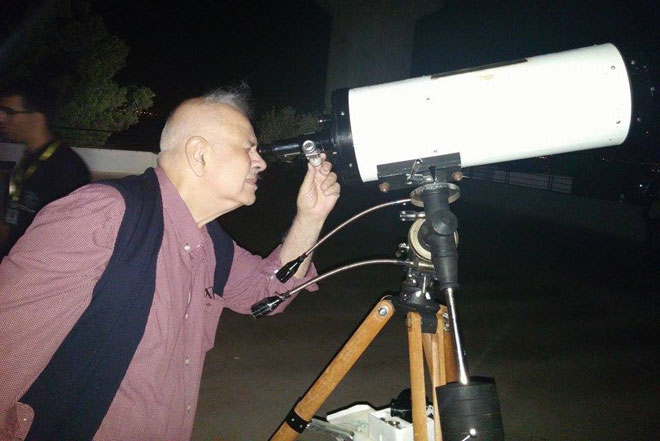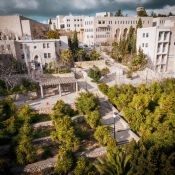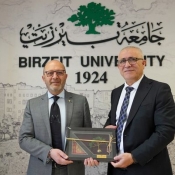Students Watch Super Blood Moon Eclipse at Campus Observatory
The Physics Department and Birzeit University student astronomy club held an event on September 27 to observe the super blood moon eclipse, which appeared in Palestine’s night sky, using the first advanced telescope in the country in the observatory officially inaugurated two weeks ago.
The event kicked off with a welcoming speech and an overview of the activities carried out by the physics department and the astronomy club, followed by a public lecture about lunar eclipse and the term “super moon.” The audience was then allowed to observe the celestial event using the advanced telescope located in the Michel and Sanieh Hakim Observatory planetarium and directly projected onto a large screen. The event began at 4 am on Monday (Jerusalem time).
The audience was also given a chance to personally watch the phases of the eclipse through different sized telescopes stationed around the observatory. Guests were also asked not to depend on technology but to observe with the naked eye the moon’s slightly red color, an event referred to as a “blood moon.”
More planets and stars within sight were observed including Venus, Mars, and Jupiter and the constellations of Gemini, Leo and Taurus.
A lunar eclipse occurs when the moon passes directly behind the Earth into its shadow. This can occur only when the sun, Earth and moon are aligned exactly, or very closely so, with the Earth in the middle. Hence, a lunar eclipse can occur only on the night of a full moon.
This is the second time a lunar eclipse has occurred in 2015. The first time happened on April 4, but it wasn’t visible in Palestine at that time. Moreover, this recent event is considered unique as the moon is at its closest point to the Earth in 2015, thus appearing brighter and larger than usual by 14 percent. This event is known as a “super moon.”
Unlike stars, the moon doesn’t shine but reflects the light of the sun, creating the illusion that it glows. The moon turns red during a full lunar eclipse, where the Earth fully obscures sunlight and prevents it from reaching the moon, but without darkening it completely.
Sunlight is composed of a range of frequencies. As sunlight passes through Earth's atmosphere, the green to violet portion of the light spectrum is filtered out. Meanwhile, the red portion of the spectrum is least affected so when it enters the atmosphere, it is refracted toward the Earth’s surface. It is then bent again when it exits on the other side of Earth. This double bending sends the red light onto the moon during a total lunar eclipse.
Despite the fact that a lunar eclipse and a super moon could occur more than one time during any given year, the combination of the two events is considered a rare occurrence in the science of astronomy. It happened 30 years ago in 1982 and will occur again 18 years later in 2033.
Over 200 astronomy enthusiasts including students, staff, and their families arrived at Birzeit University to observe this unique event. Chairman of the Board of Trustees Hanna Nasir and his family and Physics Department head and Astronomy Club supervisor Wafa Khater were also present, along with a crowd of professional photographers and enthusiasts.
Photos of the super blood moon eclipse could be found at the Facebook page of the Birzeit University Astronomy Club.







